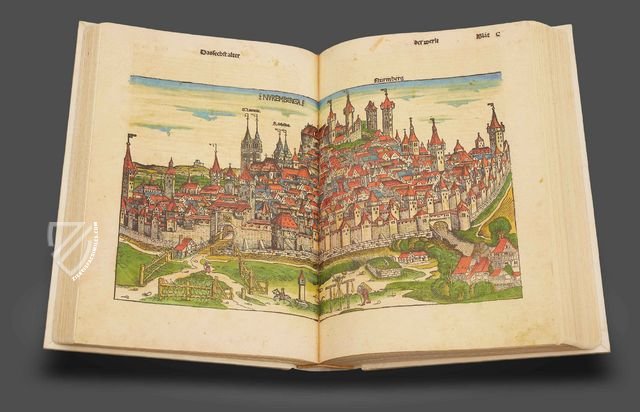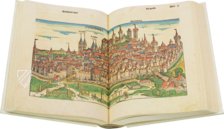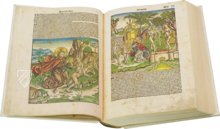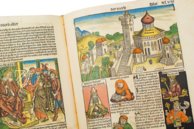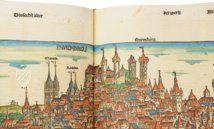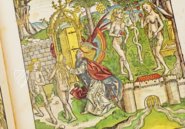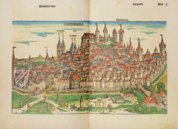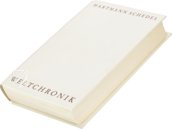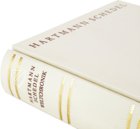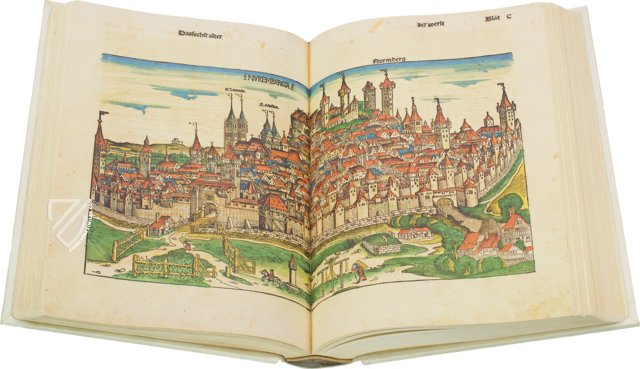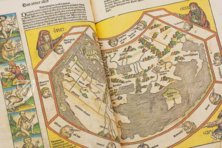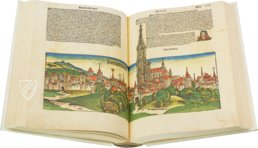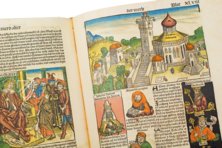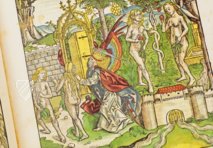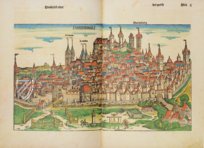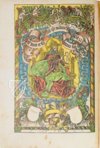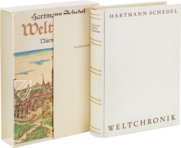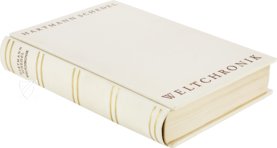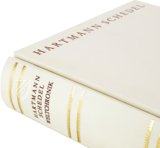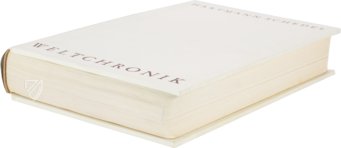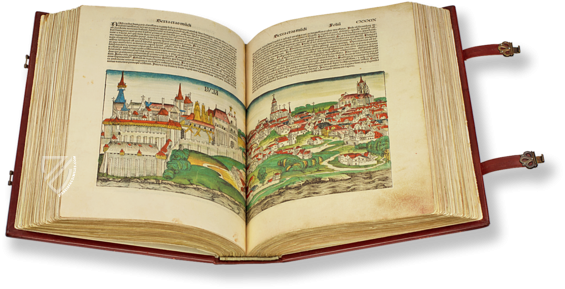World Chronicle by Hartmann Schedel
(1,000€ - 3,000€)
The World Chronicle by Hartmann Schedel (1440–1514) is a true book of superlatives. With its 1,809 woodcuts, it is particularly lavishly furnished and the large format also contributes to the imposing impression. In order to realize this courageous project, the German physician, humanist and historian teamed up with some famous names from Nuremberg. The magnificent illustrations were made in the workshop of Michael Wolgemut (1434–1519), who at the time had a very special apprentice: Albrecht Dürer (1471–1528). For the printing, Anton Koberger (ca. 1440–1513) joined the team, who first published the illustrated account of world history in a Latin and German version in 1493. Today, the 29 double-sided cityscapes with their fantastic architectures and interesting details are known above all others.
World Chronicle by Hartmann Schedel
As a book of superlatives, Schedel’s World Chronicle, measuring 44.3 x 30.8 centimeters, not only has a large-format but is also very richly illustrated with over 1,800 colored woodcuts. This extremely important illustrated incunabula appeared in Nuremberg in 1493 in a Latin and a German version. For this great book project, well-known names assembled around the doctor, humanist and historian Hartmann Schedel (1440–1514): Michael Wolgemut (1434–1519), together with his apprentice Albrecht Dürer (1471–1528), was probably responsible for the manifold woodcuts and Anton Koberger (c. 1440–1513) joined the group as printer and publisher. Today, the world chronicle is best known for its magnificent cityscapes, some of which are considered the first truly realistic representations.
World History in Seven Chapters
In the narrative, the portrayal of world history follows the tradition of medieval chronicles, in which the history of the world is divided into seven ages. The first begins with the creation of the world and the last gives a view of the end of the world and the Last Judgment. In the Nuremberg Chronicle, however, the sixth age of the world is described most extensively. It ranges from the birth of Christ to the author’s present. In addition to historical events and persons, Schedel also reports miraculous phenomena and sensations and gives geographical information, especially regarding cities and areas.
A Team from Nuremberg
For his most important work, Schedel engaged no less than Michael Wolgemut for its decoration. At this time, the painter and master of woodcuts from Nuremberg had a very important apprentice in his workshop who is famous today: the young Albrecht Dürer. Precisely how large his contribution to the Chronicle actually was remains contested among researchers. As an important printer, publisher, and merchant of the incunabula period, Anton Koberger completed the team from Nuremberg.
Famous Cityscapes
Of the total of 1,809 woodcuts, 29 are double-page cityscapes. Each of them is provided with detailed descriptions of the founding history, names and facts about contemporary culture, as well as economy and trade. These illustrations of the geographical part of the chronicle are not only popular because of their numerous delightful details. Many of them are the oldest authentic images of the cities. For example, the woodcut of Nuremberg is the first printed view of its kind.
Codicology
- Alternative Titles
- Liber Chronicarum de Hartmann Schedel
Nuremberg Chronicle
Liber Chronicarum von Hartmann Schedel
Nürnberger Chronik
Schedelsche Weltchronik
Liber Chronicarum - Schedelsche Weltchronik - Size / Format
- 594 pages / 44.3 × 30.8 cm
- Origin
- Germany
- Date
- 1493
- Epochs
- Style
- Language
- Illustrations
- 1809 colored woodcut engravings
- Artist / School
- Hartmann Schedel (author)
Albrecht Dürer (engraver)
Michael Wolgemut (engraver)
Anton Koberger (printer)
World Chronicle by Hartmann Schedel
Title Page
The woodcut at the beginning of the chronicle shows God the Father and two shields, but they are bare and lack any coats of arms. Many early printed books left blank spaces for initials and marginal décor to be completed by hand according to the wishes of the purchaser, but this practice quickly faded as the art of engraving rapidly developed. These blank shields are a remnant of that practice, indicating that this was either an unsold copy or purchased by a wealthy burgher lacking nobility.

World Chronicle by Hartmann Schedel
Cityscape of Nuremberg
This printed chronicle is renowned for its detailed and artful double-page cityscapes. Here we see the Franconian metropolis of Nuremberg, one of the largest cities in the Holy Roman Empire and the site where this wonderful incunabulum – an early printed work predating 1500 – was created and printed. Both the Latin and German names of the city are listed above.
The city is a sea of red tile roofs protected by two rings of walls with many strong towers and a gate adorned with the imperial eagle. Numerous towers inside the city bear the escutcheons of the noble families who built them and the two most important churches are labelled. Nuremberg Castle, residence of German kings and emperors, sits atop the hill overlooking the rest of the city.
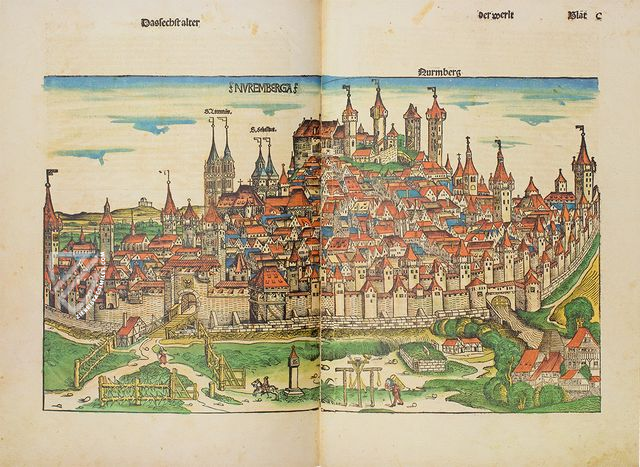
#1 Schedelsche Weltchronik
Language: German
(1,000€ - 3,000€)
- Treatises / Secular Books
- Apocalypses / Beatus
- Astronomy / Astrology
- Bestiaries
- Bibles / Gospels
- Chronicles / History / Law
- Geography / Maps
- Saints' Lives
- Islam / Oriental
- Judaism / Hebrew
- Single Leaf Collections
- Leonardo da Vinci
- Literature / Poetry
- Liturgical Manuscripts
- Medicine / Botany / Alchemy
- Music
- Mythology / Prophecies
- Psalters
- Other Religious Books
- Games / Hunting
- Private Devotion Books
- Other Genres
- Afghanistan
- Armenia
- Austria
- Belgium
- Colombia
- Croatia
- Cyprus
- Czech Republic
- Denmark
- Egypt
- Ethiopia
- France
- Germany
- Greece
- Hungary
- India
- Iran
- Iraq
- Israel
- Italy
- Japan
- Lebanon
- Luxembourg
- Mexico
- Morocco
- Netherlands
- Palestine
- Peru
- Poland
- Portugal
- Russia
- Serbia
- Spain
- Sri Lanka
- Sweden
- Switzerland
- Syria
- Turkey
- Ukraine
- United Kingdom
- United States
- Uzbekistan
- Aboca Museum
- Ajuntament de Valencia
- Akademie Verlag
- Akademische Druck- u. Verlagsanstalt (ADEVA)
- Aldo Ausilio Editore - Bottega d’Erasmo
- Alecto Historical Editions
- Alkuin Verlag
- Almqvist & Wiksell
- Amilcare Pizzi
- Andreas & Andreas Verlagsbuchhandlung
- Archa 90
- Archiv Verlag
- Archivi Edizioni
- Arnold Verlag
- ARS
- Ars Magna
- ArtCodex
- AyN Ediciones
- Azimuth Editions
- Badenia Verlag
- Bärenreiter-Verlag
- Belser Verlag
- Belser Verlag / WK Wertkontor
- Benziger Verlag
- Bernardinum Wydawnictwo
- BiblioGemma
- Biblioteca Apostolica Vaticana (Vaticanstadt, Vaticanstadt)
- Bibliotheca Palatina Faksimile Verlag
- Bibliotheca Rara
- Boydell & Brewer
- Bramante Edizioni
- Bredius Genootschap
- Brepols Publishers
- British Library
- C. Weckesser
- Caixa Catalunya
- Canesi
- CAPSA, Ars Scriptoria
- Caratzas Brothers, Publishers
- Carus Verlag
- Casamassima Libri
- Chavane Verlag
- Christian Brandstätter Verlag
- Circulo Cientifico
- Club Bibliófilo Versol
- Club du Livre
- CM Editores
- Collegium Graphicum
- Collezione Apocrifa Da Vinci
- Comissão Nacional para as Comemorações dos Descobrimentos Portugueses
- Coron Verlag
- Corvina
- CTHS
- D. S. Brewer
- Damon
- De Agostini/UTET
- De Nederlandsche Boekhandel
- De Schutter
- Deuschle & Stemmle
- Deutscher Verlag für Kunstwissenschaft
- DIAMM
- Droz
- E. Schreiber Graphische Kunstanstalten
- Ediciones Boreal
- Ediciones Grial
- Ediclube
- Edições Inapa
- Edilan
- Editalia
- Edition Deuschle
- Edition Georg Popp
- Edition Leipzig
- Edition Libri Illustri
- Editiones Reales Sitios S. L.
- Éditions de l'Oiseau Lyre
- Editions Medicina Rara
- Editorial Casariego
- Editorial Mintzoa
- Editrice Antenore
- Editrice Velar
- Edizioni Edison
- Egeria, S.L.
- Eikon Editores
- Electa
- Emery Walker Limited
- Enciclopèdia Catalana
- Eos-Verlag
- Ephesus Publishing
- Ernst Battenberg
- Eugrammia Press
- Extraordinary Editions
- Fackelverlag
- Facsimila Art & Edition
- Facsimile Editions Ltd.
- Facsimilia Art & Edition Ebert KG
- Faksimile Verlag
- Feuermann Verlag
- Folger Shakespeare Library
- Franco Cosimo Panini Editore
- Friedrich Wittig Verlag
- Fundación Hullera Vasco-Leonesa
- G. Braziller
- Gabriele Mazzotta Editore
- Gebr. Mann Verlag
- Gesellschaft für graphische Industrie
- Getty Research Institute
- Giovanni Domenico de Rossi
- Giunti Editore
- Graffiti
- Grafica European Center of Fine Arts
- Guido Pressler
- Guillermo Blazquez
- Gustav Kiepenheuer
- H. N. Abrams
- Harrassowitz
- Helikon
- Hendrickson Publishers
- Henning Oppermann
- Herder Verlag
- Hes & De Graaf Publishers
- Hoepli
- Holbein-Verlag
- Hortus Deliciarum
- Houghton Library
- Hugo Schmidt Verlag
- Idion Verlag
- Il Bulino, edizioni d'arte
- ILte
- Imago
- Insel Verlag
- Instituto Nacional de Antropología e Historia
- Istituto dell'Enciclopedia Italiana - Treccani
- Istituto Ellenico di Studi Bizantini e Postbizantini
- Istituto Geografico De Agostini
- Istituto Poligrafico e Zecca dello Stato
- Italarte Art Establishments
- J. Thorbecke
- Jan Thorbecke Verlag
- Johnson Reprint Corporation
- Josef Stocker
- Josef Stocker-Schmid
- Jugoslavija
- Karl W. Hiersemann
- Kasper Straube
- Kaydeda Ediciones
- Kindler Verlag / Coron Verlag
- Kodansha International Ltd.
- Konrad Kölbl Verlag
- Kurt Wolff Verlag
- La Liberia dello Stato
- La Linea Editrice
- La Meta Editore
- Lambert Schneider
- Landeskreditbank Baden-Württemberg
- Leo S. Olschki
- Les Incunables
- Library of Congress
- Libreria Musicale Italiana
- Lichtdruck
- Lito Immagine Editore
- Lumen Artis
- Lund Humphries
- M. Moleiro Editor
- Maison des Sciences de l'homme et de la société de Poitiers
- Manuscriptum
- Martinus Nijhoff
- Maruzen-Yushodo Co. Ltd.
- MASA
- McGraw-Hill
- Militos
- Millennium Liber
- Müller & Schindler
- Nahar and Steimatzky
- National Library of Wales
- Neri Pozza
- Nova Charta
- Oceanum Verlag
- Odeon
- Orbis Mediaevalis
- Orbis Pictus
- Österreichische Staatsdruckerei
- Oxford University Press
- Pageant Books
- Parzellers Buchverlag
- Patrimonio Ediciones
- Pattloch Verlag
- PIAF
- Pieper Verlag
- Plon-Nourrit et cie
- Prestel Verlag
- Princeton University Press
- Prisma Verlag
- Priuli & Verlucca, editori
- Pro Sport Verlag
- Propyläen Verlag
- Pytheas Books
- Quaternio Verlag Luzern
- Reales Sitios
- Recht-Verlag
- Reichert Verlag
- Reichsdruckerei
- Riehn & Reusch
- Roberto Vattori Editore
- Rosenkilde and Bagger
- Roxburghe Club
- Salerno Editrice
- Sarajevo Svjetlost
- Schöck ArtPrint Kft.
- Scolar Press
- Scrinium
- Scripta Maneant
- Scriptorium
- Siloé, arte y bibliofilia
- SISMEL - Edizioni del Galluzzo
- Sociedad Mexicana de Antropología
- Société des Bibliophiles & Iconophiles de Belgique
- Soncin Publishing
- Sorli Ediciones
- Stainer and Bell
- Studer
- Styria Verlag
- Sumptibus Pragopress
- Szegedi Tudomànyegyetem
- Taberna Libraria
- Tarshish Books
- Taschen
- Tempus Libri
- Testimonio Compañía Editorial
- Thames and Hudson
- The Clear Vue Publishing Partnership Limited
- The Facsimile Codex
- The Folio Society
- The Marquess of Normanby
- The Richard III and Yorkist History Trust
- Tip.Le.Co
- TouchArt
- TREC Publishing House
- TRI Publishing Co.
- Trident Editore
- Typis Regiae Officinae Polygraphicae
- Union Verlag Berlin
- Universidad de Granada
- University of California Press
- University of Chicago Press
- Urs Graf
- Vallecchi
- Van Wijnen
- VCH, Acta Humaniora
- VDI Verlag
- VEB Deutscher Verlag für Musik
- Verlag Anton Pustet / Andreas Verlag
- Verlag Bibliophile Drucke Josef Stocker
- Verlag der Münchner Drucke
- Verlag für Regionalgeschichte
- Verlag Styria
- Vicent Garcia Editores
- W. Turnowsky
- Waanders Printers
- Wiener Mechitharisten-Congregation (Wien, Österreich)
- Wissenschaftliche Buchgesellschaft
- Wydawnictwo Dolnoslaskie
- Xuntanza Editorial
- Zakład Narodowy
- Zollikofer AG

